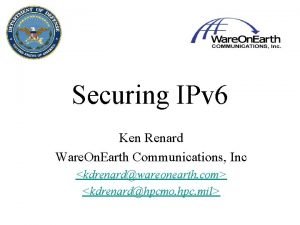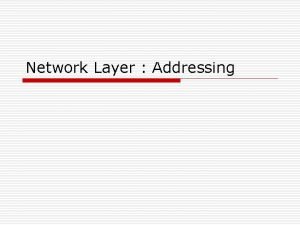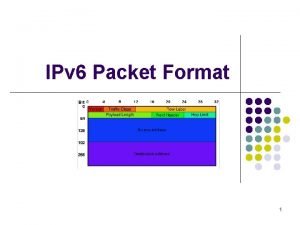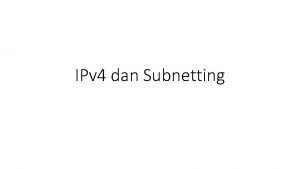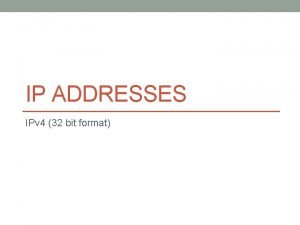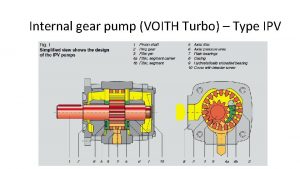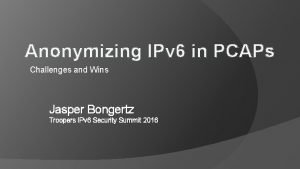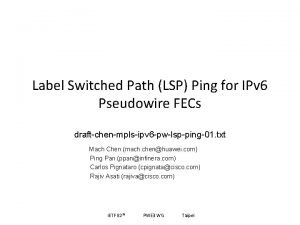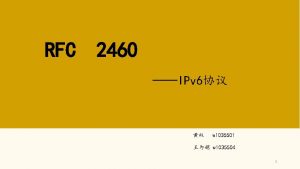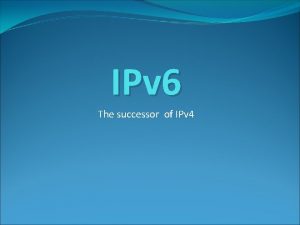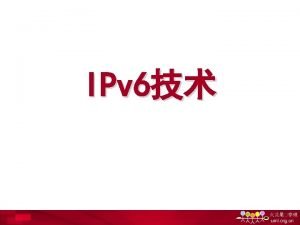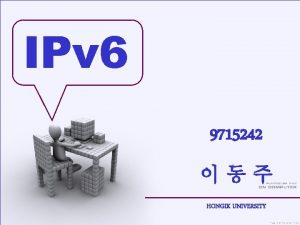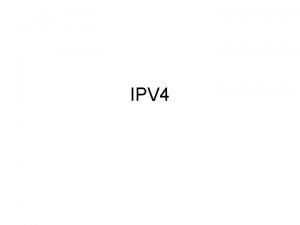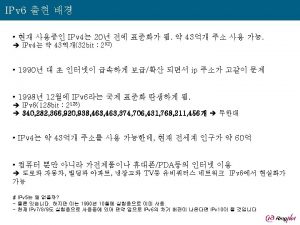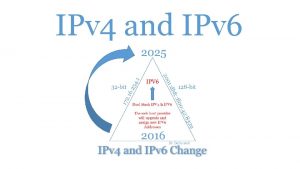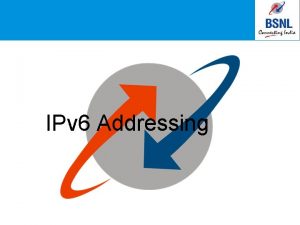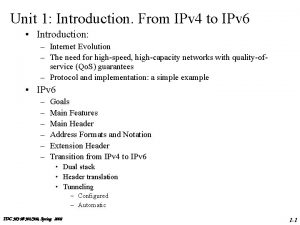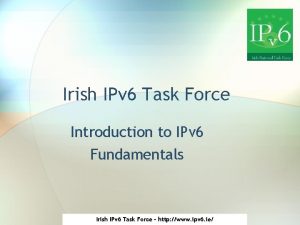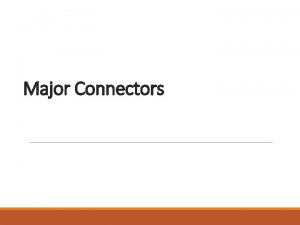IPv 4 vs IPv 6 Agenda Introduction Major



















- Slides: 19

IPv 4 vs. IPv 6

Agenda Introduction Major Advantages to IPv 6 Addresses Packet Headers Autoconfiguration Neighbor Discovery Security Difficult transition

Introduction What is IP? l The Internet Protocol (IP) is the method or protocol by which data is sent from one computer to another on the Internet. History l In 1978, the Office of the Secretary of Defense (OSD) mandated the use of IPv 4 for all “host-tohost” data exchange enabling IPv 4 to become the mechanism for the military to create integrated versus stovepiped communications.

IP Address Shortage Proliferation of Internet devices: 405 M mobile phones sold in 2000 l 1 B+ by 2005 l New emerging populations: l China, Korea, Japan, India, Russia Solution = IPv 6

Advantages to IPv 6 Larger address space Reduce end-to-end delay Higher level of security Mobility No fragmentation Network autoconfiguration

Address Formats IPv 4 l 32 -bit Ex: 192. 156. 136. 22 IPv 6 l 128 bits Ex: 1080: 0: 8: 800: 200 C: 417 A Or in compressed format: 1080: : 8: 800: 200 C: 417 A

IPv 4 Classes

IPv 6 Address Types Unicast Global aggregatable l Site local l Link local l IPv 4 compatible l Anycast Multicast No more broadcast!

Unicast Addresses An address for a single interface l Global:

Anycast An address for a set of interfaces that typically belong to different nodes.

Multicast An address for a set of interfaces (in a given scope) that typically belong to different nodes.

IPv 4 Packet Header The basic IPv 4 packet header has 12 fields with a total size of 20 octets (160 bits).

IPv 6 Packet Header The basic IPv 6 packet header has 8 fields with a total size of 40 octets (320 bits).

Neighbor Discovery Replaces ARP, ICMP, etc. Used for l l Router discovery Parameter/Prefix discovery Address resolution Address auto-configuration Can provide the means to renumber home subnets by forwarding solicitations to other subnets.

Autoconfiguration Used by Neighbour Discovery IPv 6 no longer needs: ARP l RARP l DHCP l BOOTP l Stateless vs. Stateful

Security Authentication Header (AH) § § IPv 6 datagrams not encrypted Keyed MD 5 hashing algorithm proposed for standard authentication algorithm § § Eliminates IP spoofing Eliminates Host Masquarading Encapsulating Security Payload Header (ESP) § § Provides data integrity and confidentiality DES CBC encryption algorithm as standard (2 Modes) § § Tunnel Mode: Whole IP packet encrypted (including header) Transport Mode: Only payload encrypted

Difficult Transition Some have already begun experimenting with IPv 6 on the internet Dual IP layer IPv 6 -over-IPv 4 tunneling For timeline information of the transition efforts, browse http: //www. ietf. org/html. charters/ngtrans-charter. html


Bibliography Tech. Target, (2000), Internet Protocol, Retrieved February 24 th, 2002 from http: //searchnetworking. techtarget. com/s. Definition/0, sid 7_gci 214031, 00. html Deering, Stephen (2001), Future-Proofing the Internet, Retrieved February 24 th, 2002 from www. cisco. com/warp/public/756/industryanalysts/presentations/ipv 6_presentations. pdf Brig, Micheal (2002), A History of the Internet, Retrieved February 25 th, 2002 from http: //ngi. spawar. navy. mil/history_of_internet. html Schmid, Stefan (1998), IPv 6 benefits, Retrieved February 24 th, 2002 from http: //www. comp. lancs. ac. uk/computing/users/sschmid/Spie/node 7. html Osterman, Shawn (2002), Internet Addresses, Retrieved March 12 th, 2002 from http: //oucsace. cs. ohio. edu/~osterman/class/cs 444. archive/notes/chap 4. pdf
 Agenda sistemica y agenda institucional
Agenda sistemica y agenda institucional Introduction meeting agenda
Introduction meeting agenda Introduction meeting agenda
Introduction meeting agenda Agenda for mentor meeting
Agenda for mentor meeting Ipv meaning
Ipv meaning Ipv 4
Ipv 4 6 packet
6 packet Ipv 4 terdiri dari...
Ipv 4 terdiri dari... Ipv format
Ipv format Voith gear pump
Voith gear pump ۰میکنی
۰میکنی Ipv meaning
Ipv meaning Ipv foo
Ipv foo Portalipv
Portalipv Lsp ping
Lsp ping Ipv 4 terdiri dari... *
Ipv 4 terdiri dari... * Ipv 4 terdiri dari... *
Ipv 4 terdiri dari... * Ipv protocol
Ipv protocol 1035504
1035504 Ipv merieux fachinformation
Ipv merieux fachinformation




